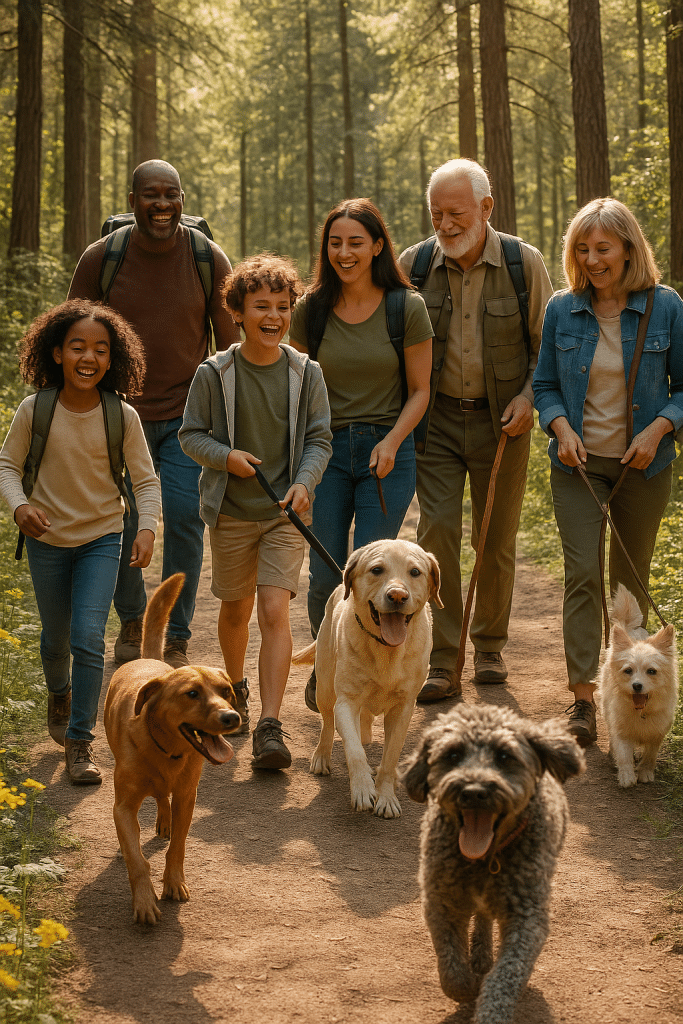If you’re like me, nothing beats the joy of hitting the trails with your furry companion and loved ones. Finding great dog friendly hiking trails that offer safe, scenic, and engaging experiences for both dogs and their families can sometimes feel like searching for a needle in a haystack. But don’t worry—I’m here to walk you through five of the best trails that perfectly blend accessibility, training opportunities, and natural beauty. Whether you have a young pup still learning commands or an energetic adult dog needing a vigorous workout, these trails cater to all breeds and fitness levels.
In this article, I’ll help you understand what to expect from dog friendly hiking trails, how to pick trails based on your dog’s breed and training stage, and share detailed overviews of top trails that are ideal for family outings and dog training alike. Plus, I’ll cover essential gear, training tips, hydration strategies, and environmental responsibility so your outdoor adventures can be fun, safe, and eco-friendly. Let’s get started on tailoring your hikes to fit your dog’s needs and create lasting memories for your whole family.
Understanding Dog Friendly Hiking Trails: What to Expect
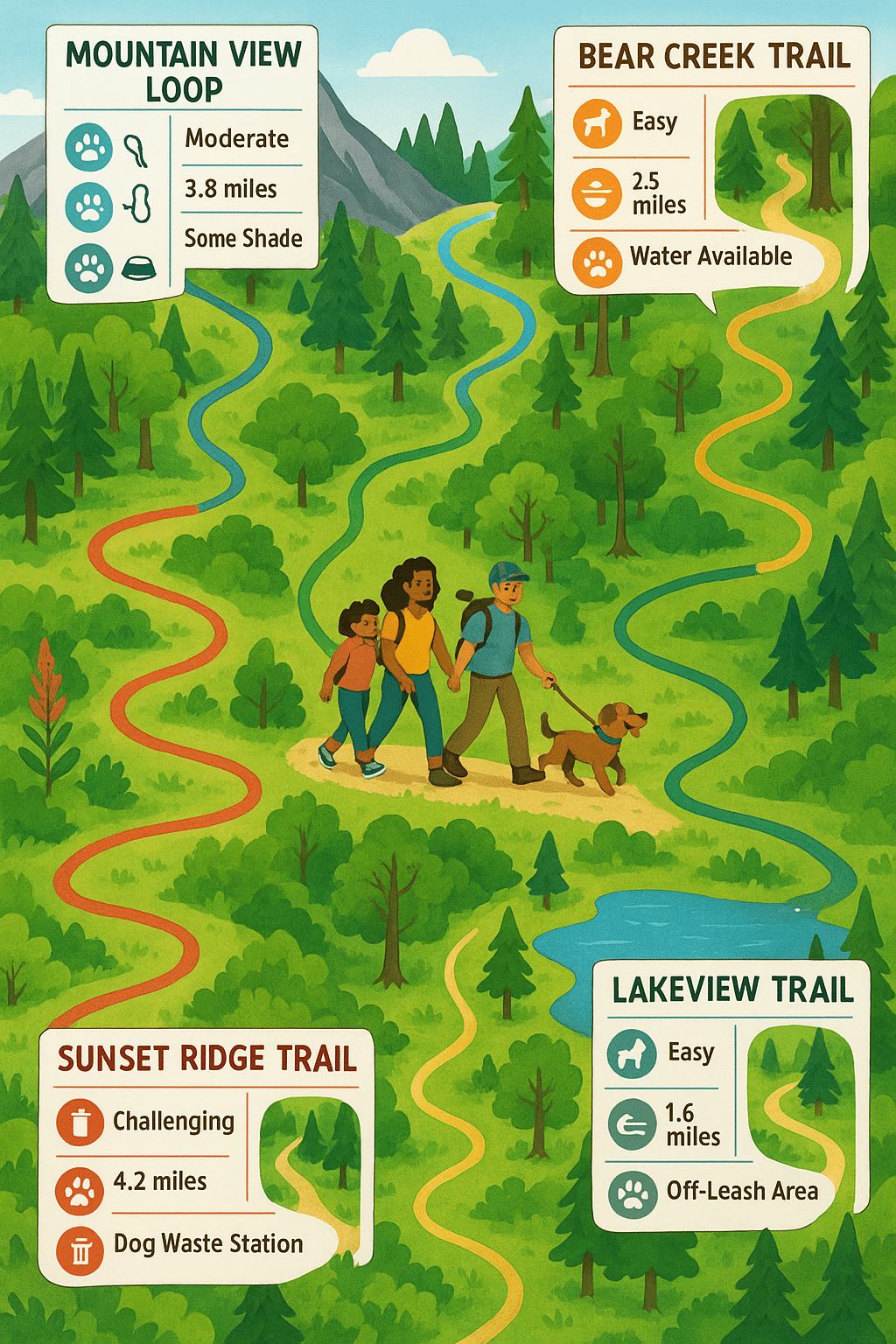
Trail Accessibility and Family Suitability
Not all trails are created equal, especially when you’re hiking with dogs and children. Accessibility means more than just the physical ease of the terrain—it includes parking availability, clear trail signage, restroom facilities, and whether the trail is stroller-friendly for families with young kids.
For example, moderate-grade trails with wide, well-maintained paths work best for families. Trails like the Big Bear Lake Dog Park Trails have gentle elevation changes, ample shade, and designated rest spots that suit both energetic dogs and little feet. When trails are too rugged or steep, it risks exhaustion or injury for kids and pets, so always check trail maps and elevation profiles beforehand.
Ideally, the trail should offer multiple entry and exit points, so you can shorten or extend your hike based on how your dog and kids are feeling that day. Amenities such as dog waste stations and benches are added bonuses that make family outings smoother.
Safety Considerations for Dogs and Hikers
Safety is paramount on dog friendly hiking trails. Always begin by researching local regulations—some areas require dogs to be on leashes while others have off-leash zones designed specifically for training and play. Knowing leash laws helps prevent conflicts with wildlife, other hikers, and prevents your dog from running into dangerous spots.
Look for trails with natural water sources, but be mindful that stagnant water can harbor harmful bacteria; bringing your own filtered hydration source is a smart move. Avoid trails during the hottest parts of the day to prevent heatstroke—a risk not just for kids but for our pooches too. Signs of distress like excessive panting, drooling, or lethargy mean it’s time to take a break or cut the hike short.
Wildlife encounters are another concern. Trails passing through dense forests or grassy areas are habitats for snakes, ticks, and other critters that can threaten dogs. Carrying pet first aid supplies and knowing how to handle emergencies increases your confidence on the trail.
Trail Etiquette: Respecting Wildlife and Other Hikers
Good trail etiquette keeps the trails open and welcoming to dogs and families long-term. Always keep your dog under control and pick up their waste promptly. Many dog friendly hiking trails provide waste disposal stations to make cleanup easy and environmentally responsible.
When passing other hikers or dogs, a polite “on your left” or gentle reminder to leash your dog keeps communication clear and minimizes surprises. If your dog tends to be reactive, keeping a safe distance helps avoid unnecessary stress or confrontations.
Stay on marked paths to protect delicate ecosystems, and resist the urge to let your dog chase wildlife. The last thing you want is disturbing nesting birds or stressing small mammals. Following these unspoken rules helps preserve trail habitats and keeps your hike enjoyable for everyone.
Choosing the Right Hiking Trail for Your Dog’s Breed and Training Level
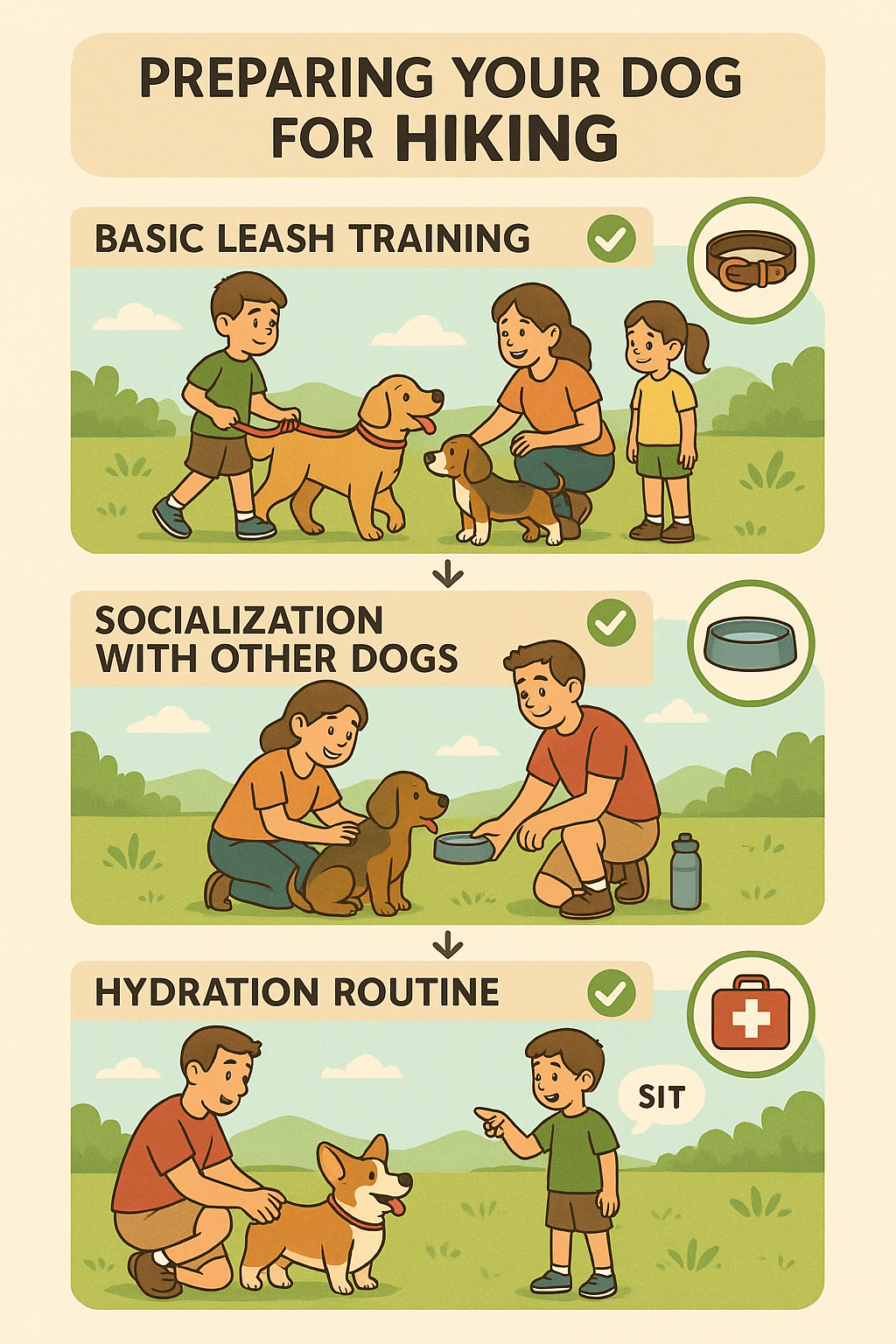
Matching Trail Difficulty to Dog Breed Exercise Needs
Different dog breeds have different exercise capacities and preferences, so matching the trail difficulty is key. For instance, large working breeds like Border Collies and German Shepherds thrive on long, challenging hikes with varied terrain that keeps them stimulated. Trails like those in Shenandoah National Park offer steep climbs and diverse ecosystems, perfect for energetic breeds.
Conversely, smaller breeds or brachycephalic (short-nosed) dogs such as French Bulldogs or Pugs do better on easy, shaded trails with frequent water breaks due to their breathing constraints. Flat terrains near water bodies, such as the Lake Minnewaska Preserve, provide enjoyable, manageable experiences.
Age and health also influence trail selection—puppies and senior dogs usually require shorter, gentler hikes. Listening to your dog’s stamina and physical cues can save you from pushing them too far.
Finding Trails with Training-Friendly Features and Obstacles
If you’re training your dog on the trail, look for areas that naturally add challenges like low logs, rocks, or varied surfaces. Trails that incorporate switchbacks, gradual inclines, or river crossings give opportunities to practice commands like “stay,” “leave it,” or “come” in distracting environments.
Some trails even feature dedicated dog obstacle zones or off-leash areas perfect for reinforcing recall and socialization. For example, the Rancho San Antonio Open Space Preserve has fenced dog parks with agility equipment nearby, ideal for blending hiking and training.
Using these natural or manmade features keeps training sessions dynamic and rewarding, ensuring your dog remains mentally sharp and physically responsive during hikes.
Leash Laws and Off-Leash Opportunities for Different Trails
Every dog owner appreciates a good off-leash run, but local regulations dictate where and when it’s allowed. Many prime dog friendly hiking trails have mixed leash policies—requiring leashes in parking areas and during busy times but allowing off-leash exploration during low-traffic hours.
Before you set out, always check the trail’s official website or local park guidelines. Some popular trails like the Griffith Park Trails have designated off-leash zones, but most require leashes due to wildlife protection or safety concerns.
Leashing your dog in compliance with rules protects your dog from hazards and prevents conflicts with wildlife and other visitors. Carrying a sturdy, comfortable leash and a long training line provides flexibility to give your dog freedom while maintaining control.
Top 5 Dog Friendly Hiking Trails Perfect for Families and Training
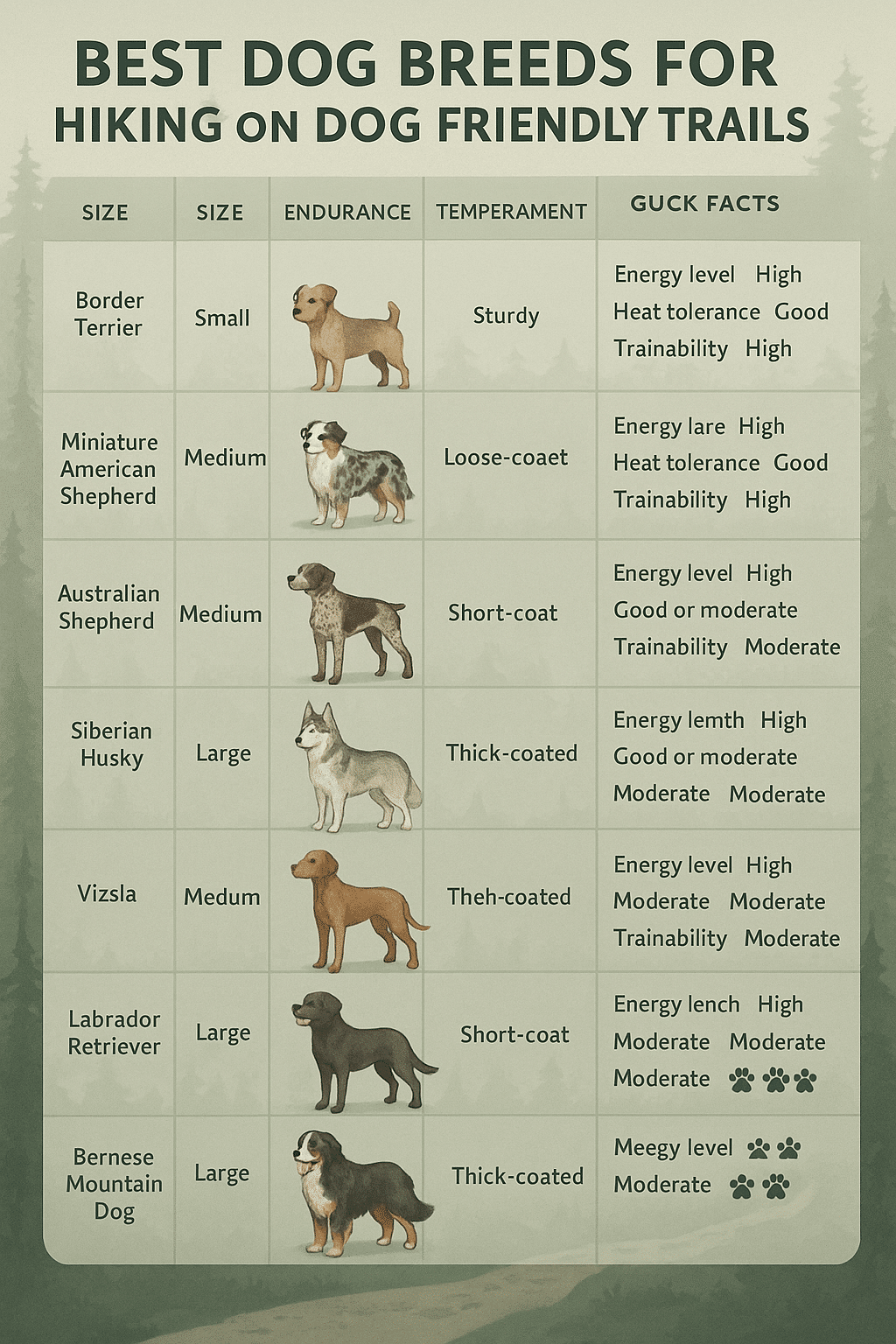
Trail #1: Maple Ridge Trail
Location: Blue Ridge Mountains, Virginia
Difficulty: Moderate (3.5 miles loop)
Dog Amenities: Water stations, shaded rest areas, multiple dog waste stations, moderate off-leash zones
Maple Ridge Trail offers an ideal balance of natural beauty and dog-friendly features. Its shaded path winds through a lush forest, offering an invigorating hike without too much steep climbing—the perfect mix for families with children and active dogs. The presence of water stations helps keep pups hydrated, and multiple waste stations encourage responsible cleanup.
Training Opportunities and Family-Friendly Features on Maple Ridge Trail
This trail’s steady terrain allows dogs to practice walking “heel” without distractions while providing spots with natural obstacles such as fallen logs and shallow streams. Kids can join in, learning about trail safety and dog behavior alongside responsible pet ownership. The dog off-leash sections here are safely gated, allowing recall training without worry.
Trail #2: Pinewood Creek Loop
Location: Oregon Coast Range
Difficulty: Easy to moderate (4 miles)
Dog Amenities: Beach access, water crossings, dog wash station
Pinewood Creek Loop is a scenic gem with beautiful creekside paths and light elevation changes. The access to tide pools and small beaches is a favorite for water-loving dogs, especially breeds like Labradors and Retrievers that enjoy swimming.
Training Opportunities and Family-Friendly Features on Pinewood Creek Loop
The varied terrain—muddy banks, sandy beaches, creek wading spots—provides excellent training grounds for commands like “wait,” “come,” and “leave it,” reinforcing discipline even in exciting new environments. The onsite dog wash station helps clean off salty water and sand before hopping into the car with the family.
Trail #3: Cedar Hills Nature Trail
Location: Colorado Front Range
Difficulty: Moderate (5 miles) with rocky sections
Dog Amenities: Leash-required sections, scenic overlooks, dog waste stations
Cedar Hills Nature Trail features panoramic mountain vistas and rugged footing, suited to more physically fit dogs and families. The changing trail surfaces encourage good paw care and build endurance.
Training Opportunities and Family-Friendly Features on Cedar Hills Nature Trail
Rock scrambles and switchbacks on this trail mimic real-world obstacles that sharpen your dog’s balance and agility. Kids will love spotting wildlife, learning the importance of trail etiquette, and assisting with dog care tasks such as hydration breaks and checking paws for debris.
Trail #4: Willow Creek Path
Location: Northern California
Difficulty: Easy (2.5 miles loop)
Dog Amenities: Fully fenced dog play areas, picnic tables, shaded paths
Willow Creek Path is a laid-back, family favorite with a gentle pace and ample shaded spots, making it great for puppies or older dogs requiring slower hikes or training sessions.
Training Opportunities and Family-Friendly Features on Willow Creek Path
The large fenced off-leash dog park adjoins the trail, where training recall and socialization with other dogs can occur safely. Easy path conditions also allow for focus on verbal and hand-command training for younger family members eager to teach their pets.
Trail #5: Silver Lake Ridge Trail
Location: Appalachian Mountains
Difficulty: Moderate to difficult (6 miles round trip)
Dog Amenities: Waterfalls, fishing streams, dog waste stations, limited leash-free zones
For active families and endurance breeds, Silver Lake Ridge Trail offers an invigorating climb with stunning waterfall views rewarding each step. Dogs that love exploring various terrains and water features will feel right at home.
Training Opportunities and Family-Friendly Features on Silver Lake Ridge Trail
Steep inclines and rockier surfaces make this a prime spot for building canine stamina and practicing advanced commands like “stay” on uneven ground. The waterfall pools provide natural incentives for dogs to cool down and reward themselves after disciplined effort.
Essential Gear for Dog Friendly Hiking and Training
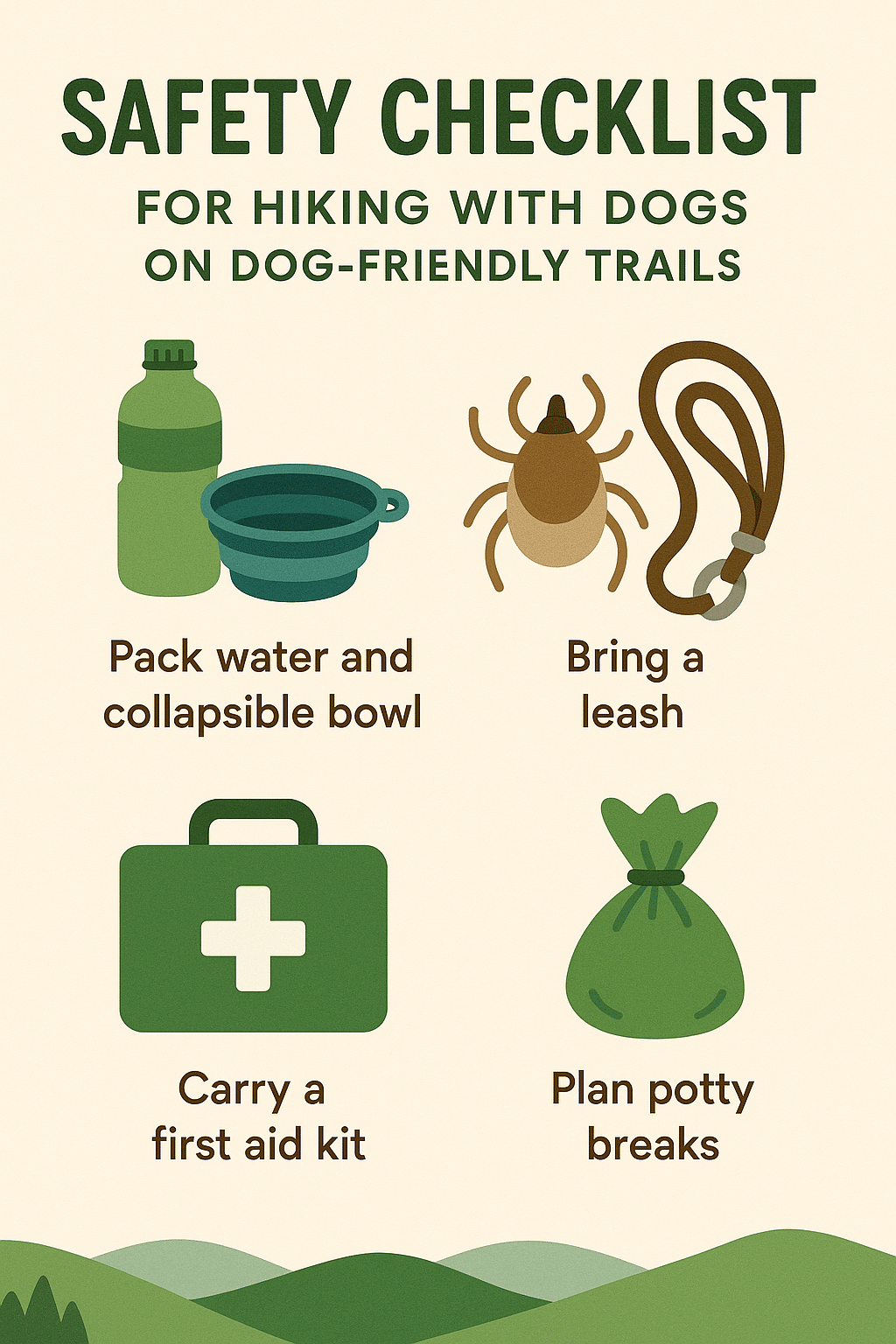
Dog Backpacks, Paw Protection, and Hydration Solutions
Investing in a properly fitted dog backpack lets your pup carry water, snacks, or waste bags, keeping them engaged and less likely to overburden you. Popular options like the Ruffwear Approach Pack distribute weight evenly and offer pockets sized for daily hikes.
Dogs’ paws take a beating on rough terrain, so booties like Muttluks protect against sharp rocks, hot surfaces, and thorny brush. Don’t forget hydration gear—collapsible bowls and portable water bottles ensure fresh water is available anytime on the trail.
Pet First Aid Kits and Safety Accessories
Carrying a pet first aid kit tailored for hikers helps you address scrapes, ticks, or paw injuries quickly. Kits should include antiseptic wipes, tick removers, bandages, and emergency contact info.
Safety accessories like reflective collars, GPS trackers (e.g., Whistle GO Explore), and LED lights come in handy for early morning or dusk hikes. Preparing for unexpected trail situations keeps safety high and stress low.
Preparing Your Dog for Hiking: Training Commands and Behavior Tips
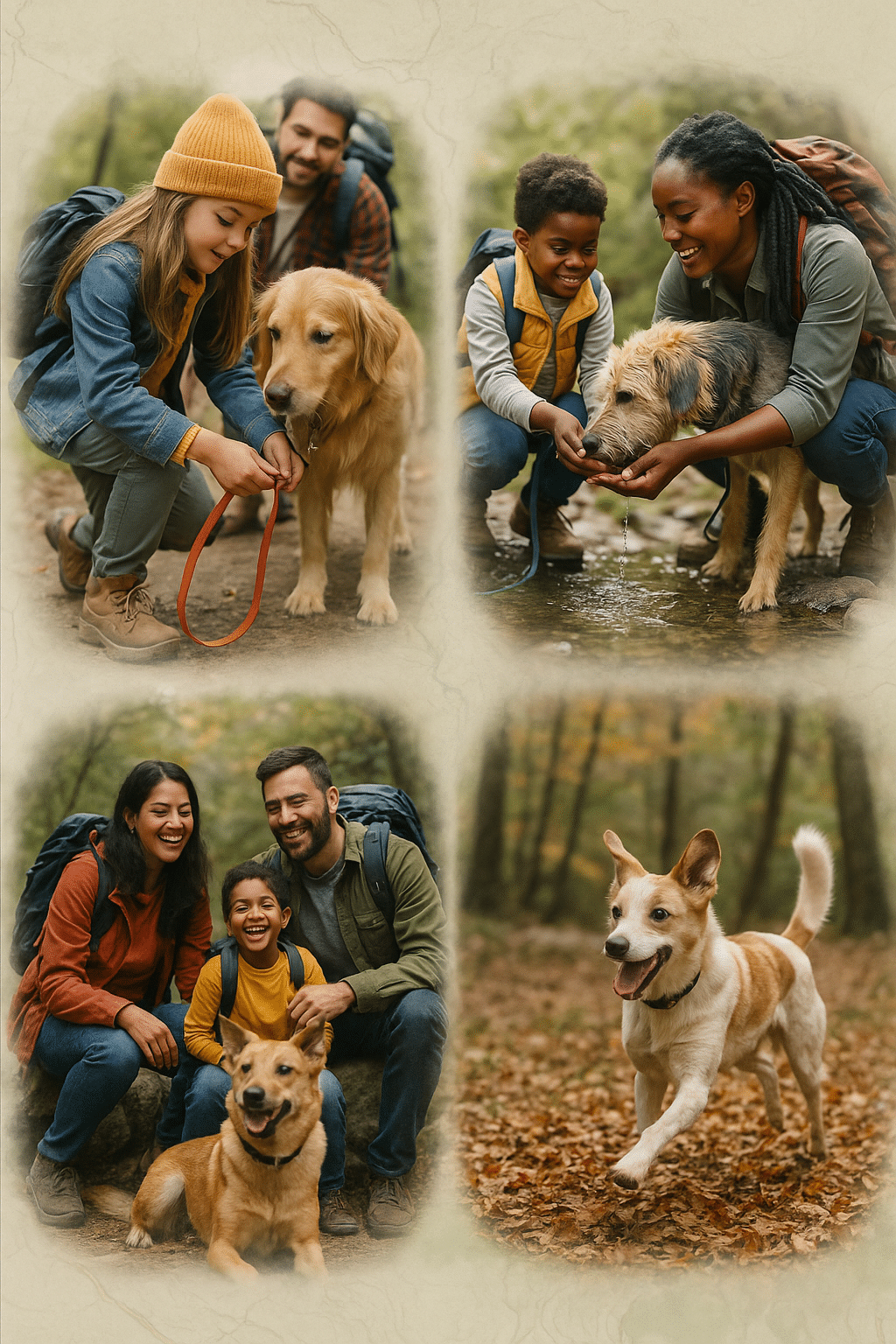
Basic and Advanced Commands for Trail Safety
Before hitting any dog friendly hiking trails, your dog should master basic commands—“come,” “stay,” “heel,” “leave it,” and “wait.” These commands are vital for controlling your dog near wildlife, other dogs, and tricky terrain.
As your dog progresses, add advanced training like “place” (stay in one spot), recall from distances, and controlled play release. Regular training sessions off-trail and on easy paths build confidence and obedience tailored for unpredictable environments.
Building Endurance and Fitness for Hiking with Your Dog
Gradually increasing your dog’s activity level helps build stamina and prevents injury. Start with short walks or easy trails, then extend distance and intensity as your dog’s fitness improves.
Activities like fetch, swimming, and stair climbing supplement hiking prep by strengthening muscles and improving cardiovascular health. Always monitor for signs of overexertion—legging behind, heavy panting, or limping mean rest is needed.
Managing Canine Hydration and Nutrition on the Trail
Recognizing Signs of Dehydration and Heat Stress
Dogs don’t sweat like humans; they rely mostly on panting to cool down. Watch for excessive drooling, bright red gums, lethargy, or stumbling as early dehydration or heat stress signs.
Giving water at frequent intervals, preferably before your dog shows signs of thirst, and avoiding mid-day hikes in hot weather reduces these risks. Cooling pads or damp towels can provide extra relief on hot days.
Healthy Snack Options for Active Dogs
Bring nutrient-dense, portable snacks like freeze-dried liver treats, dehydrated sweet potatoes, or specially formulated dog energy bites to refuel your dog’s energy. Avoid feeding table scraps or sugary treats that can upset digestion.
Environmental Responsibility and Eco-Friendly Waste Disposal
Best Practices for Dog Waste Management on Trails
Always carry biodegradable dog waste bags, pick up after your pet, and dispose of waste in provided bins or carry it out if none exist. Leaving waste on trails contaminates soil and water and can spread disease to wildlife and other dogs.
Adhering strictly to this etiquette ensures trails remain open to dog owners and minimizes environmental impact.
Minimizing Your Pet’s Impact on Trail Ecosystems
Stay on marked trails to avoid damaging native plants and habitats. Try to keep your dog close to avoid chasing wildlife or trampling sensitive areas. Avoid feeding wildlife and carrying out all pet supplies to keep these natural areas pristine for future visitors.
Unique Benefits of Family Hiking with Dogs: Bonding and Learning Opportunities
Strengthening Family Connections Through Shared Outdoor Activities
Hiking trails with your dog create quality time for families to bond through shared physical activity and teamwork. Dogs act as natural icebreakers, encouraging kids and adults alike to engage more fully with nature and each other.
Teaching Children About Pet Care and Outdoor Safety
Family hikes provide a hands-on classroom where kids learn responsible pet ownership, trail safety, and respect for nature. These lessons create lifelong skills and build empathy toward animals and the environment.
Additional Resources for Dog Friendly Hiking and Training
Apps and Online Tools for Locating Dog Friendly Trails
Some great resources include:
- AllTrails — Filters for dog friendly and family-friendly hikes with user reviews
- BringFido — Lists dog-friendly parks, trails, and accommodations nationwide
- Rover Trails — Community-shared dog hiking experiences and tips
Local Clubs, Training Groups, and Community Events for Active Dogs
Joining local hiking clubs or canine training groups connects you with fellow pet owners for group hikes, training workshops, and social play.
Check community boards, local Facebook groups, or sites like Meetup for events tailored to families with dogs. These networks provide motivation, support, and opportunities to learn from experienced dog trainers.
FAQs
Q1: What are the best dog friendly hiking trails for large breeds?
Large breeds often need longer, more strenuous hikes with terrain variety. Trails like Maple Ridge Trail and Silver Lake Ridge Trail offer the ideal mix of length, elevation, and natural water sources to keep large dogs engaged and fit.
Q2: Are there safe dog friendly hiking trails for puppies?
Yes! Trails like Willow Creek Path feature gentle terrain and shaded areas perfect for young dogs still building endurance. Keep hikes short and always bring plenty of water.
Q3: Can I find dog friendly hiking trails with off-leash play areas?
Many popular trails, including Pinewood Creek Loop and certain sections of Maple Ridge Trail, offer gated off-leash zones or specific off-leash hours. Always verify local leash laws before letting your dog off-leash.
Q4: What equipment should I bring for hiking with my dog?
Essential gear includes a comfortable dog backpack like the Ruffwear Approach Pack, paw protection booties, collapsible water bowls, a pet first aid kit, and a sturdy leash with a long line for training flexibility.
Q5: How can I manage my dog’s hydration on hikes?
Bring fresh water and offer it frequently, ideally before your dog shows thirst. Avoid stagnant water sources, and monitor your dog for early signs of dehydration like excessive panting and drooling.
Quick Takeaways/Key Points
- Choose trails based on your dog’s breed, age, and fitness level for safe, enjoyable hikes.
- Train your dog on basic and advanced commands to maintain control and safety on trails.
- Bring essential gear including hydration solutions, paw protection, and pet first aid items.
- Practice responsible trail etiquette like cleaning up waste and respecting wildlife.
- Family hikes with dogs build bonds and teach children valuable lessons in pet care.
- Use apps and community groups to discover dog friendly hiking trails and events.
- Stay mindful of environmental impact to keep trails accessible and beautiful for all.
Conclusion
Embarking on dog friendly hiking trails is one of the most rewarding ways to combine your love for the outdoors with your passion for caring for your dog and family. By thoughtfully selecting trails based on your dog’s breed and training needs, equipping yourself with the right gear, and practicing safe hiking and waste management, you can ensure your adventures are not only fun but also responsible and safe.
I encourage you to explore the five trails I’ve detailed here—their unique features, training opportunities, and family-friendly amenities provide a fantastic framework to build unforgettable outdoor experiences. As you hit the trail, cherish each step with your dog and family, knowing you’re fostering fitness, trust, and connection in the great outdoors.
Ready to get walking? Grab your pack, leash, and that infectious canine enthusiasm, and head out to discover your next favorite dog friendly hiking trail!

